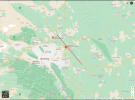persephone
New Member
Hello, long time lurker here, first time making a post because I couldn’t find a topic on this particular video. Sorry if this is a repeat post.
This clip was posted to Reddit a few days ago. It shows a clip played on Mexican TV apparently recorded by a pilot coming in to land at Monterrey airport on July 5th 2023.
The relevant part of the video is right at the start (around 10s in), and appears to show a black object darting around above the cloud level. It leaves some kind of trail behind it and zig-zags back on itself several times. According to the pilot it was keeping pace with the plane, though it looks quite a bit lower in altitude to me. The movement looks similar to an insect buzzing around, except it appears to be much larger (I think it’s unlikely there are insects close to the plane at that altitude but I haven’t looked deeply into this).
Source: https://www.reddit.com/r/UFOs/comments/17ixoqa/black_tictac_like_object_recorded_by_pilot_in/?utm_source=share&utm_medium=mweb
Screenshot of object:

The Reddit post described the shape as a tic-tac but it doesn’t look very distinctly elongated to me.
This is roughly the direction of travel of the plane:

What do you think can explain this recording? I don’t see the object casting a shadow on the clouds below but that might be because of the angle of the recording.
Thanks in advance.
This clip was posted to Reddit a few days ago. It shows a clip played on Mexican TV apparently recorded by a pilot coming in to land at Monterrey airport on July 5th 2023.
The relevant part of the video is right at the start (around 10s in), and appears to show a black object darting around above the cloud level. It leaves some kind of trail behind it and zig-zags back on itself several times. According to the pilot it was keeping pace with the plane, though it looks quite a bit lower in altitude to me. The movement looks similar to an insect buzzing around, except it appears to be much larger (I think it’s unlikely there are insects close to the plane at that altitude but I haven’t looked deeply into this).
Source: https://www.reddit.com/r/UFOs/comments/17ixoqa/black_tictac_like_object_recorded_by_pilot_in/?utm_source=share&utm_medium=mweb
Screenshot of object:
The Reddit post described the shape as a tic-tac but it doesn’t look very distinctly elongated to me.
This is roughly the direction of travel of the plane:

What do you think can explain this recording? I don’t see the object casting a shadow on the clouds below but that might be because of the angle of the recording.
Thanks in advance.
Last edited by a moderator:
